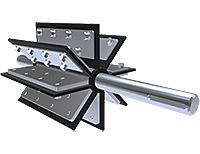
Is your rotary valve squeaking, squealing, or hissing? Sounds a bit like a hungry cat, but our valves are easier to tame.
It’s normal for rotary airlock valve parts to wear down over time, depending on how long you’ve had the valve and how often you do maintenance. If it’s making strange sounds that you’ve never heard before, it’s time to investigate.
To find out why your valve is so noisy, the first step is to shut down your system and perform lockout tagout procedures so it’s safe to inspect your system and look for one of these common issues.
Scenario 1: The rotor clearances are worn
The most common reason for squeaking valves is decreased rotor clearances. While increased rotor-to-housing clearances are another source of valve issues, the clearances can also decrease due to material buildup or thermal expansion from your system’s heat.
Measure the rotor-to-housing clearances to see if they’re within the recommended range. You can do this with either a feeler gauge or dial indicator, depending on how your rotary valve is constructed. Check your valve manual for full instructions.
Clean any material buildup you find on the rotor and housing, remove any stuck material, and adjust the clearances if needed. If that doesn’t work, contact ACS Valves for help.
Scenario 2: The bearings failed
Failed bearings can also cause noise issues in your valve. Bearings help prevent material contamination and leakage, so it’s important you replace faulty bearings as soon as possible.
If you decide to replace the bearings, we recommend replacing the shaft seals as well. You can find guides to all that in your trusty manual.
Scenario 3: There's a problem with the drive chain
Squealing noises could indicate a mechanical problem with the drive chain or drive shaft. Usually, this has to do with the drive chain or drive shaft rubbing against the guard. You may be able to stop the noise by simply adjusting the position of the guard, sprockets, or both.
The airlock’s drive chain tension changes with normal wear, so make sure you check the chain every 200 hours of operation to make sure it isn’t loose or damaged.
Scenario 4: Your valve is rotating the wrong way
If you just installed the rotary valve recently and it’s making noise, it’s possible you’re operating it in reverse, causing mechanical parts to come into contact when they shouldn’t. Running the valve in reverse can cause jamming and motor overload.
Check the markings on the valve to make sure you have it set up in the right direction. You may need to rewire the motor to correct this fully.
Need help with that?
The ACS Valves support team knows conveying systems from top to bottom, so if you’re having trouble with a really sticky issue, we can help pinpoint the right solution.
When you’re requesting help from our service department, it’s very useful to have these types of details on hand:
- Serial number, ACS Sales Order number, or drawing number if available
- Application conditions of service such as product, temperature, and ambient temperature
- Vacuum or pressure gauge reading above and below the valve
- Airlock speed
- Method of feeding the valve
- Blower speed
- Pressure switch setting
- Blower motor amperage reading
- Gearmotor amperage reading
- Conveying line length
- Horizontal run
- Vertical run
- Number of elbows
- Photos or video of the installation
Once you have that, all you have to do is give us a call.


